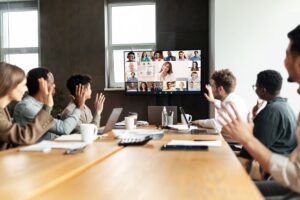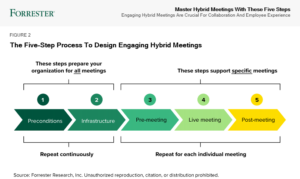Mastering Hybrid Meetings Is A Critical Priority
Employees are overwhelmed with meetings: back-to-back meetings; poorly run meetings; and just flat-out too many meetings. The frequency of meetings increased by 13% during the first year of the pandemic, and leaders tell us those meetings were sticky — they never fell off of calendars. Add in the complications caused by working in the messy middle of hybrid, across in-person and remote, and meetings threaten to become productivity-sapping energy vampires.

(Image source: Adobe Stock)
Hybrid Meetings Aren’t Working
Employees are widely back to the office in hybrid fashion, but today’s hybrid meetings aren’t working as well as they should:
- In-person participants too often find themselves looking at their laptops while sitting next to colleagues in a conference room … making them wonder why they’re in person at all.
- Remote participants still suffer from poor experiences. Viewing a conference room filled with colleagues through a distorted lens, while worrying about being heard, doesn’t inspire.
- Videoconference participants, whether in-room or remote, aren’t turning on their video: New 2023 data reveals that fewer than half of hybrid meeting participants turn on video. And the more people in the meeting, the more cameras are off.
Developing A Meeting Strategy Drives Business Results
Companies are waking up to the perils of runaway meetings: Shopify recently nuked 322,000 hours of meetings off of employee calendars via IT action and enforces a new meeting-free Wednesday policy. Too radical for your organization?
It’s time to develop a meeting strategy that works for you. Our new report, Master Hybrid Meetings With These Five Steps, offers a pathway. The first two steps put your organization in the best possible place to succeed with meetings, developing Preconditions (the culture, relationships, and practices that underpin meetings) and Infrastructure (the technology context, tailored specifically to hybrid) that prepare your company and its employees to be great at hybrid meetings. The next three steps support specific meetings, with actions you should take Pre-Meeting, during the Live meeting, and Post-meeting. In our report, we lay out specific recommendations and practices at each step. Ultimately, you’ll collaborate more effectively and provide space for employees to become more productive.

I can work with clients to help you design a meeting strategy that engages employees. Clients can request a guidance session with me. To go even deeper, we can conduct a workshop (held in hybrid fashion, of course) to help you execute our five-step model. But first, read the report to get started.
J. P. Gownder is a vice president and principal analyst on Forrester’s Future of Work team.
